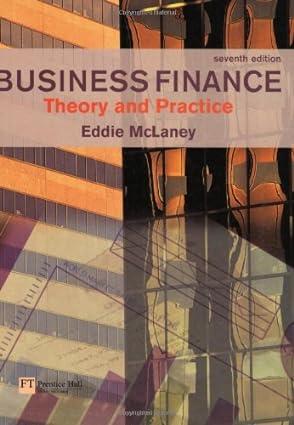Question
1.Which of the following statements is FALSE? a.In a leveraged lease, the lessor needs to borrow to get the initial capital for the purchase, and
1.Which of the following statements is FALSE? a.In a leveraged lease, the lessor needs to borrow to get the initial capital for the purchase, and then rely on the lease payments to pay interest and principal. b.If a firm already owns an asset it would prefer to lease, it can arrange a sale and leaseback transaction. In this type of lease, the lessee receives cash from the sale of the asset and then makes lease payments to retain the use of the asset. c.The amount of the lease payment will only depend on the purchase price and the residual value. d.The lessor receives the depreciation deductions associated with the ownership of the asset when a true tax lease is used. Meanwhile, the lessee can treat the amount of the lease payments as an operating expense.
2.Which of the following statements is FALSE? a.Shareholders need to elect the directors of the company. Shareholders also need to approve many major actions taken by the board. b.Managerial ownership can alleviate the conflicts of interest between managers and shareholders. c.A resolution at the annual meeting can only be submitted by the largest shareholder. d.If the pay-for-performance sensitivity in managerial compensation is larger, other things equal, managers bear a higher level of risk.
3.Which of the following statements is FALSE? a.Business interruption insurance protects the firm against the loss of earnings if the business is interrupted due to fire, accident, or some other insured peril. b.If a firm is subject to graduated income tax rates, insurance can produce tax savings if the firm is in a higher tax bracket when it pays the premium than the tax bracket it is in when it receives the insurance payment in the event of a loss. c.Having insurance can benefit firms by reducing their need for external capital and thus reduce issuance costs. d.Insurance companies need to charge the insurance premiums higher than the actuarially fair price, only when they need to cover administrative and overhead costs.
4.Which of the following statements is FALSE? a.If there is a lower level of uncertainty regarding what the value of the investment will be in the future, the option to wait will be less valuable. b.It is easy to ignore or understate the importance of the option to abandon. In many applications, killing an economically unsuccessful venture can add more value than starting a new venture.
c.As real options can be very valuable, it is common for real options to be traded in competitive markets. d.Due to the option to wait, an investment that currently has a negative NPV can have a positive value.
5.Which of the following statements is FALSE? a.If a firm uses a cash offer for its seasoned equity offering, it offers the new shares only to existing shareholders. b.Angel financing often occurs at such an early stage in the business that it is difficult to assess a value for the firm. Angel investors often circumvent this problem by holding either a convertible note or a SAFE (simple agreement for future equity) rather than equity. c.The shares that are sold in the IPO may either be new shares that raise new capital, known as a primary offering, or existing shares that are sold by current shareholders, known as a secondary offering. d.Investors who can buy shares from underwriters at the IPO price, usually benefit from the first-day trading.
6. Which of the following statements is FALSE? a.There are two primary mechanisms by which ownership and control of a public corporation can change: Either another corporation or group of individuals can acquire the target firm, or the target firm can merge with another firm. b.Even when the merger itself does not create economic value, the earnings per share of the merged company could exceed the premerger earnings per share of either company. c.Managers conduct mergers only because they want to maximize shareholder value. d.Other things equal, the larger the synergy is, the higher the exchange ratio is.
Step by Step Solution
There are 3 Steps involved in it
Step: 1

Get Instant Access to Expert-Tailored Solutions
See step-by-step solutions with expert insights and AI powered tools for academic success
Step: 2

Step: 3

Ace Your Homework with AI
Get the answers you need in no time with our AI-driven, step-by-step assistance
Get Started


